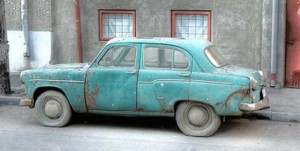
A cash-for-clunker deal could help the auto industry, boost consumer spending by $25 billion -- and yield huge benefits for the environment, according to a new study.
A well-executed program encouraging American motorists to trade in their “clunkers” for new vehicles could not only give a big boost to the auto industry but inject as much as $25 billion in much needed consumer spending into the troubled economy, according to a new study.
Such a program – which has already proved highly successful in Europe – would work at the state level, as well, boosting local economies, and it would have a significant benefit on the environment, since older cars, trucks and crossovers emit far more pollution than new ones, says the consulting firm, CSM Worldwide.
 “When it comes to scrappage programs, simpler is better,” says Craig Cather, president and CEO of CSM. “The more clear-cut the value proposition is for consumers and the fewer exclusions and limitations it has, the more successful it will be.”
“When it comes to scrappage programs, simpler is better,” says Craig Cather, president and CEO of CSM. “The more clear-cut the value proposition is for consumers and the fewer exclusions and limitations it has, the more successful it will be.”
Recent efforts to introduce cash-for-clunker programs have failed – including one proposed as part of the Obama stimulus package – in part because of controversial exclusions. Proponents had hoped to put the emphasis on domestic manufacturers or products solely produced in U.S. assembly plants.
But support for a broader program has been growing, in recent weeks, and Cather insists it is time to move.
“Acting quickly and limiting the program to several months will create a sense of urgency and deliver sales when the economy needs them the most,” Cather added. “If we get this right, it will be a tremendous opportunity for consumers to upgrade to safer, greener vehicles with unprecedented affordability.”
The consulting firm proposes a program aimed at generating a million additional sales, which, at the current pace of the American auto market, would boost demand by a full 10 percent or more. Considering the average cost of today’s vehicle is about $25,000, CSM notes that would add up to an injection of $25 billion in new cash into the industry and the economy. Because of other factors, the program would also yield:
- $1.4 billion in new state sales taxes;
- Since newer vehicles are generally more fuel-efficient, CSM estimates the program would save 250 million gallons of gasoline annually;
- In turn, that would reduce by 2.5 million tons the annual production of CO2.
The study warns that a cash-for-clunker program will need to offer significant incentives – enough to not only lure buyers back into the market, but also to ensure they can make their new monthly payments. The $3,000 to $5,000 incentives that have so far been proposed might not be enough – unless supplemented by additional rebates from the carmakers, cautions CSM.
“Automakers will need to continue – and possibly enhance – the cash incentives they
offer and ensure that low-cost credit is available to convince enough people to part with
their clunkers and take on a monthly car payment in this economic climate,” says Michael Robinet, CSM vice president, global vehicle forecasts.
Earlier cash-for-clunker plans focused on getting American motorists to switch to some of the most fuel-efficient products on the market. But CSM research suggests that is an ineffective approach. A motorist who owns a full-size pickup isn’t likely to swap it for a subcompact sedan, no matter what the cash incentives.
But even getting that buyer to swap for a newer pickup would be beneficial to the economy, the auto industry – and the environment – asserts the research firm. It points out that a new Dodge Ram 4×4 pickup with a 5.9-liter V-8 is so much more efficient than a comparable 2001 model that it produces 2 tons less CO2 each year.
CSM also warns against overly-protective legislation, which could create problems with the nation’s trading partners. The company notes that in 2010, more than half the vehicles assembled in the U.S. will be assembled at plants owned by foreign-based manufacturers, such as Toyota, Mercedes-Benz and Hyundai, and that their collective employment base is now approaching the six-figure mark, even as Big Three jobs continue to be cut.
“Free trade,” asserts Robinet, “makes our industry stronger.”
